Despite all possible efforts, the decision to examine Ramappa Temple for a World Heritage Site inscription has been deferred by the World Heritage Committee, according to the provisional agenda accessed by #KhabarLive. The World Heritage Committee’s Extended 44th meeting is in action online hosted in Fuzhou in China between July 16 and 31.
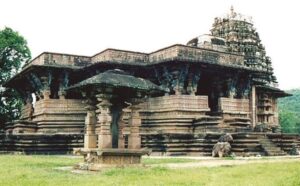
Despite it being one of the most well-maintained, preserved and protected historical sites in South India, and having attracted heritage lovers around the world for centuries, the Ramappa temple is still to get recognition from UNESCO.
Recently, a team led by Ministers Errabelli Dayakar Rao, V Srinivas Goud and Satyavathi Rathod, MLC Pochampally Srinivas Reddy and other officials, visited New Delhi and made a strong pitch to the Centre to nominate Ramappa for the UNESCO tag.
The team pointed out that it has been described as “the brightest star in the galaxy of medieval temples of the Deccan” by the Venetian traveller Marco Polo and that it has many unique facets that set it apart from other shrines.
Unfortunately, the decision to examine Ramappa temple for a World Heritage Site inscription has been deferred by the World Heritage Committee, according to the provisional agenda.
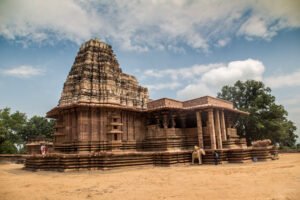
Reportedly, the nomination is in its final stages.
On its part, the Kakatiya Heritage Trust sent documentation sought by UNESCO. Videos were sent in Arabic, Spanish, Chinese, French, Russian, and English.
Though disappointed with the reports that a decision on the tag has been deferred, heritage enthusiasts are confident of the temple getting the World Heritage Site tag, if not in the forthcoming meeting, then later.
Speaking to #KhabarLive, Indian National Trust for Art and Cultural Heritage (INTACH) convener Anuradha Reddy pointed that Telangana state doesn’t have any World Heritage Site recognised by UNESCO, barring the Chowmahalla Palace under Asia Pacific Region.
She said, “Until Ramappa temple is recognised, we have to find comfort in Hampi as a World Heritage Site, with it being in the Deccan region. Perhaps UNESCO found some things that needed to be redefined in the application, after their visit to the site in September 2019, they had asked for a few clarifications. We have now been asked to take advice from ICOMOS too, to redefine the nomination approach.”
With the World Heritage Committee deferring a decision, there is nothing much the State government can do. However, the Union government needs to provide the additional information it has been asked, and provide the necessary support.
“The Telangana government’s push will enable us to get this recognition. It will, in turn, prove to be a huge boost to the economy and the tourism department,” Anuradha Reddy says.
Well-known Telugu historian Captain Lingala Pandu Ranga Reddy, a member of the Royal Historical Society, differs.
He says the problem behind the UNESCO deferring could also be due to the inefficient representation of the cause. “Neither is there a good MP who cares about the cause, nor are some good universities willing to take this up. There also is a lot of bureaucracy that seeps in that is to be blamed. Don’t even get me started on the bias that goes on at various levels,” Captain Reddy says.
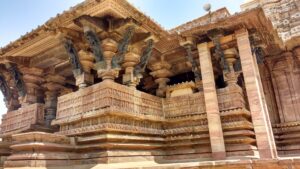
It is also important for the team to be assured of the maintenance of the temple, Anuradha Reddy says.
“The last time I visited Hampi, I saw some horrible bridges being built at the site, with the money allotted by the Karnataka state government. The toilets there merge into the backgrounds. Such glaringly obvious things need to be kept in mind. The government must ensure and assure that once the Ramappa temple is rewarded the recognition, care will be taken to maintain the place with utmost commitment,” Anuradha Reddy says.
However, every heritage lover agrees that the Ramappa temple has all it takes to be recognised as a masterpiece by UNESCO.
The temple is devoted to Shiva, more particularly Rudreswara, one of the many avatars of the Destroyer. Ramappa temple – also known as Rudreswara temple – is located in Palampet, a valley 65 km from Warangal.
The shrine is probably the only temple in India known by the name of the sculptor who worked tirelessly on it and not after the presiding deity, Ramalingeswara, as is the norm.
The temple has been rightfully described as the “brightest star in the galaxy of medieval temples of the Deccan” a repository of Kakatiyan creative genius, with intricate carvings adorning the walls, pillars and ceilings of this marvellous edifice.
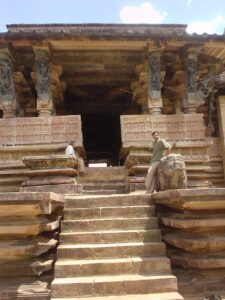
Apart from the main temple, there are three more ancillary shrines. To the north is Koteswara temple, on the south is Kameswara temple, Narasimha Swamy temple Sabha mantapa on the southwest and on the western side is the serene Ramappa lake of the same age as the temple.
A temple and an irrigation tank besides each other is unmistakably Kakatiyan.
The temple was built on behalf of the king, Kakati Ganapathi Deva by his commander-in-chief Rudra Samani at a place called Ranakude in Atukuru province.
He was greatest among all Kakatiya rulers and ruled for a long period, from 1198 to 1262. Ganapathi Deva’s rule saw the building of many artisan temples, thoranas and wells. He also issued ‘Abhaya Sasanam’ at Motupalli port, as a charter of security to merchants to promote foreign trade. The inscriptions on the walls of the Sri Veerabhadra swamy temple bear testimony to these facts, observes epigraphist Jyothi Chandramouli.
It was during his rule that Telugu inscriptions began to appear in the Warangal area.
His daughter Rudramadevi was the first woman ruler in the Kakatiya dynasty, and it was during her reign that Marco Polo, the traveller, wrote about the dynasty, temples, and her administration.
The famous poet Tikkana Somayaji was the court poet during this time.
Ganapathi Deva assumed the title of ‘Rayagajakesari’ and was a great patron of trade and commerce. Kakati Devi, the tutelary deity of Kakatiya rulers was the presiding deity at this 13th-century temple.
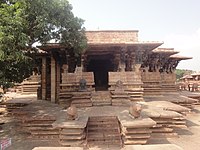
In the 12th Century, he built the iconic Kakatiya Thoranam. This ornate arch has several similarities with the gateways at the Sanchi Stupa and is also the emblem of Telangana State.
The scenic Pakhal lake in Warangal was also created during his rule. Another example of the exquisite Kakatiya architecture is the 1,000 pillar temple in Warangal that was built during this era. It is said that the Koh-i-Noor, which is now among the jewels set in the British Crown, was mined and first owned by the Kakatiya Dynasty.
The Kakatiya Dynasty came to an end when the Delhi sultanate defeated it in 1323 A.D.
The Ramappa temple is a best example of the love for art, music and dance as patronised by the Kakatiyas. The temple is situated in a valley and is built with bricks so light that they literally float on water, established after scientific research conducted indicating the creative masterpieces of the time. While the temple bodies were built of prefabricated red sandstone, the shikharas were made of bricks. These bricks were built with special technology that made them feather light and spongy, thus enabling them to float on water.
They used red sandstone for the temple while black granite was used to carve statues adorning the temple outside connecting the roof and walls. The dancing girls in erotic forms bring out the artistic splendour of those days.
The columns were arranged in such a fashion that sunlight reflects on the garbhagriha all the time. The temple withstood many wars, invasions and natural calamities. It’s surrounded by a stone compound wall and has two low entrances, one towards the east and the other to the west; the main entrance gate facing east in the outer wall of the temple is now ruined, so one can only enter through a small west gate.
Advancing from the eastern entrance, the visitor first notices the remains of a ruined Nandi Mandapa (pavilion).
In front of the Nandi pavilion stands the main temple on a 6’4″ high star-shaped platform. The plinth of the platform instead of being plain has been divided into foliating surfaces which give a very pleasing effect to the general appearance of the structure.
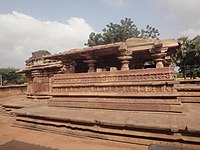
The main entrance, like in any typical Hindu temple, faces east with balustrade steps and porches on three entrances on the east, south and north with two six feet high female figures on either side of the three entrances, a total 12 life-sized dancing girls, with different voluptuous poses fixed at an angle on high brackets.
Carved from black basalt, some of these figures are ornate with decorative jewellery while others are simple. All of them are tall, ferocious and noble, carrying swords, arrows and bows, and are called Madanika, Nagini, Alasakanya and Salabhanjika. There are red sandstone dancing figures on all sides of the temple. On the outer walls there are carved figures of animals and war scenes in the same red sandstone.
These carvings are of a very heterogeneous character, and consist of gods, goddesses, warriors, acrobats, musicians. The sculptural work of dance postures in the temple appears like a frozen record of dances of the region in stone and was of great inspiration for the famous work ‘Nritya Ratnavali’, by Jayapa Senani.
The postures pertaining to Bharata Natya, Shrunga, Bharunga, Rathi, Perini Nritya etc., are engraved on the pillars and top-beams of ‘Mukha Mandapam’, The mythological episodes such as ‘Gopika Vastrapaharanam, Tripura samharam, Daksha Samharam, Ksheera Sagara Madhanam, Girija Kalyanam etc., stand for the highest standards of Kakatiya sculpture.
The ‘Nagini’ and other eleven devanarthakis are arranged as supporting beams on both sides of each entrance. The aesthetic sense which scaled innumerable heights in Kakatiya sculpture is clearly evident in these 12 postures of devanarthakis. The desi (local) varieties of dances such as Perini, Prenkana, Sudda Nartana, Dandarasak, Sivapriya, Chindu and Kolata are some dance forms in the sculptural art of the temple.
The famous treatise of dance ‘Nritya Ratnavali’ of Kakatiya period is said to have been inspired by the construction and art work on Ramappa temple.
Some specialities of this temple include a statue of Nandi that is not in the sitting position. The Nandi is sculptured with its feet up, ready to stand, which deviates from the norm of seated Nandi bull sculptures.
Kakatiya rulers who built this temple tried to make the temple earthquake proof. They did so by using a technique called sandbox. In this method, sand is placed on the land where a building is planned to be constructed.
The sand is placed so that it can absorb any shock from an earthquake, thus minimising damage to the building.
Sand was commonly used in the foundations.
Depending on the size, architecture and area of the construction, the builders used to dig at least 3 meters for the foundation. The pit was filled with sand and for the sand mixture to become strong, it was later mixed with the powder mixture of granite, jaggery (bellam in Telugu) and Terminalia Chebula (Karakkaya in Telugu).
Sandbox technology was used in areas that reported low-intensity earthquakes, while in areas that suffered high-intensity earthquakes, a unique technique where small tunnel-like holes were bored through the stones used in the construction of walls, pillars and rooftops.
Molten iron was poured into these tunnel-like holes which then formed iron dowels that held these stones together. In the event of high-intensity earthquakes, if the vibrations were so intense that they passed through sandboxes and reached the foundation, the iron dowels would keep the structure together. These dowels would hold the rocks together making the total construction fit like a frame and stronger.
The temple withstood a major earthquake in the 17th Century and suffered minimal damage.
On the other side, the UNESCO tag would bring a lot of perks, the biggest one being funding.
The site would be eligible to receive funds for its protection and conservation.
Also, the UNESCO tag would bring recognition of its historical significance and would give a boost to its preservation efforts. The site will also have access to global project management resources if a repair is needed or if more options for tourism were needed to ensure protection.
Once a site gets the UNESCO tag, it becomes more attractive for travellers and consequently, travel writers and other news organisations will help spread the word.
The site suddenly would have a certain status that it didn’t have before and could help bring new economic benefits. The next thing would be that in case of a war, UNESCO protects the site under the Geneva Convention.
Some of the UNESCO World Heritage Sites in India are the Taj Mahal, Ajanta Caves, Hampi, Humayun’s Tomb and the Konark Sun Temple.
In all, there are 38 World Heritage Sites in India, as of 2021. In the tentative list for the World Heritage Site acknowledgement, there are 48 sites including the Varanasi Ghats, Satpura tiger reserve and the Kanchipuram temple.
Meanwhile, a senior heritage expert said that the Qutb Shahi Tombs in Hyderabad stand a better chance of getting the tag over the Ramappa temple. “The officials who have pressed for its nomination very well knew it wouldn’t fit the bill. What UNESCO is looking for is a universal appeal; there are several other temples in India that could bag the tag over the Ramappa temple. Unless the government puts in a whole-hearted effort to give the place a world-class facelift, I see no future in the temple being given the World Heritage Site tag,” the expert claimed. #KhabarLive #hydnews
